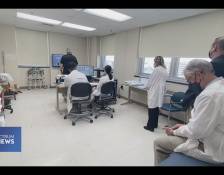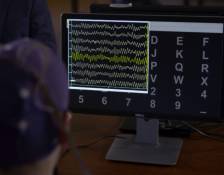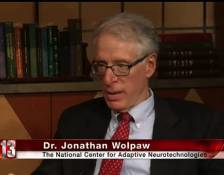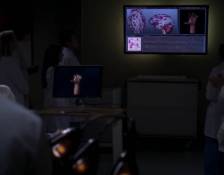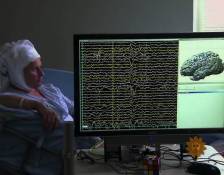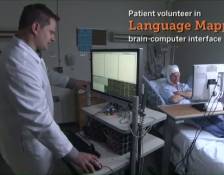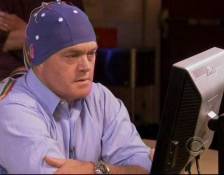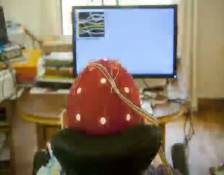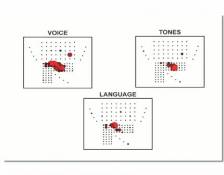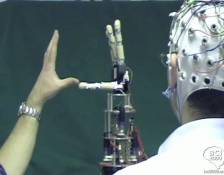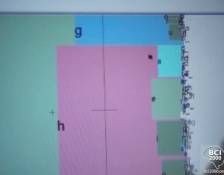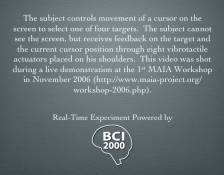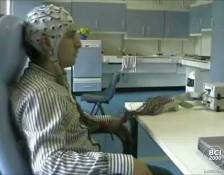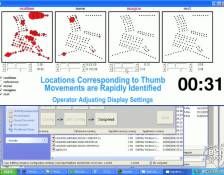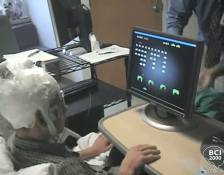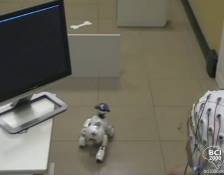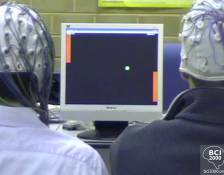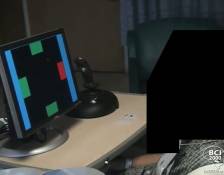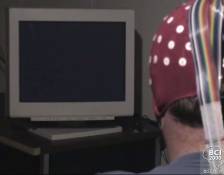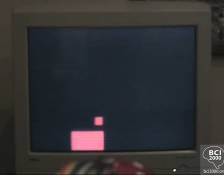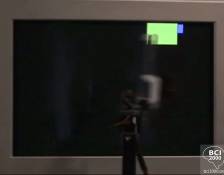Videos
April 13, 2023
For four decades, a group of neurologists now lead by Jonathan Wolpaw have entered the research lab with one goal in mind: Understanding how the nervous system changes with disease and injuries so when something goes wrong, doctors would have a tool to fix it.
"It's a very exciting time both for us and in general in neuroscience, because it's become clear that there's a lot we can do that 30, 40 years ago we thought was impossible," said Wolpaw, a research neurologist. "When the nervous system was damaged, you were stuck with it and that was it. That's not the case."
What's changed that is a device that helps restore movement, enabling the nervous system to recover after severe injury, such as a stroke or a spinal cord injury.
"You can see that our participant has electrodes on the skin of his calf," Wolpaw said. "He also has a set of electrodes behind the knee. And what we're doing is recording muscle activity from the skin, and we're also periodically giving a very weak electrical stimulation, which is barely perceptible, but it produces a reflex."
In most participants, researchers have found the feedback they see on the screen encourages them to learn to make that reflex smaller, ultimately improving the ability to walk for stroke survivors like Scott Bennett.
"I've noticed, you know, for the last couple of months that, you know, my, you know, my arm is, you know, bouncing...creeping up as much when I walk. And I mean, I would have a tendency to drag my right foot, and I'm not doing that as much," said Bennett, a research participant.
With hundreds of scientists, volunteers and involvement from research facilities across the globe, their work has culminated to something that's expected to help millions of people.
Scott said he's proud to play even a small role in that.
"It is very important. There's a lot of people that, you know, could be helped with this...to live better lives," he said.
Within the next few years, it's expected to be translated into clinical use. In as little as five years, patients could use the technology at home with remote oversight through telemedicine.
"A patient could then have this therapy available every day," Wolpaw said. "It would be a lot more impactful. The results could be a lot better and it'd be a lot more loved, a lot less expensive and a lot more practical for widespread use."
August 26, 2020
This documentary follows Peter Scott-Morgan, diagnosed with Motor Neuron Disease. He is using NCAN's brain-computer interface (BCI) assistive technology to maintain his ability to communicate as his disease progresses.
July 19, 2017
Drs. Jonathan Wolpaw and Gerwin Schalk of the National Center for Adaptive Neurotechnologies discuss the research at the Center and how it is being applied to improve the quality of life for those with spinal cord injuries and neurological disorders.
October 24, 2013
This Grey's Anatomy episode features brain mapping technology developed at NCAN.
October 22, 2013
This news segments showcases the Brain-Computer Interfaces research at NCAN.
October 10, 2011
This ABC Sunday Morning segments features NCAN's work on developing a way to translate thought into speech.
November 23, 2010
This American Museum of Natural History in Manhattan had a large exhibit entitled "Brain - The Inside Story". It included a video prominently featuring our ECoG-based studies.
August 1, 2009
This episode of CNN's Edge of Discovery showcases NCAN brain-computer interface research at Wadsworth, and highlights members of our team.
November 2, 2008
This feature of CBS 60 Minutes describes NCAN's Wadsworth BCI, and its promise for restoring communication to people who are completely paralyzed, such as people with amyotrophic lateral sclerosis (ALS). Scott Pelley wears an EEG cap and spells words with his brain signals using NCAN's Wadsworth home BCI system.
January 27, 2014
This video shows the Wadsworth BCI Home System, which a small number of people with late-stage amyotrophic lateral sclerosis (ALS) now use for basic communication and other purposes at home. This video is intended for the user’s caregiver to describe how to set up the system, how to place the electrode cap and work with the operating system.
June 26, 2012
This video article "Recording Human Electrocorticographic (ECoG) Signals for Neuroscientific Research and Real-time Functional Cortical Mapping" by Dr. Jeremy Hill et al. gives an overview of the principles and practice of ECoG-based research. The video prominently highlights Jeremy Hill, Peter Brunner, and Disha Gupta from our laboratory, as well as our collaborators Tony Ritaccio and Matt Adamo from Albany Medical College.
February 19, 2008
In this movie, a subject uses scalp-recorded sensorimotor rhythms to control a robotic arm in two dimensions (one dimension controls the thumb; the other dimension controls the other fingers). The subject’s task is to mimick hand gestures shown by a technician.
December 1, 2006
In this movie, a subject uses scalp-recorded sensorimotor rhythms to control a computer cursor in one dimension (up/down). The subject’s task is to select characters using the word processing software “Dasher.” The subject spells the word “hello” in 30 seconds.
November 15, 2006
The subject controls movement of a cursor on the screen to select one of four targets. The subject cannot see the screen, but receives feedback on the target and the current cursor position through eight vibrotactile actuators placed on his shoulders. This video was shot during a live demonstration at the
November 15, 2006
A subject demonstrates selection of an item from an icon-based menu using a 2-state BCI that is controlled by scalp-recorded mu-rhythm modulation. In a first scene, the subject turns off the light. In a second scene, the subject unlocks the front door (the person entering the room is visible in the lower left panel of the screen, monitored by a video camera). The assistive device software controls each actuator using signals communicated using wireless or powerline communication.
October 15, 2006
Electrocorticographic (ECoG) signals are recorded from 128 locations over frontal, temporal, and motor cortices, using BCI2000 software. The subject is instructed to move the left thumb, to imagine the same action, or to rest in response to visual cues. The BCI2000 SIGFRIED module determines activity change in mu/beta frequency bands and translates that change into the diameter of a circle at each electrode location. Areas corresponding to thumb movement are rapidly identified.
September 15, 2006
In this movie, a subject uses electrocorticographic (ECoG) signals recorded from the surface of the brain to control a space ship in the classic game “Space Invaders.” The subject’s task is to steer the space ship left or right so as to avoid being hit. The space ship automatically fires.
September 15, 2005
A subject uses the BCI to navigate a robotic dog along a path to its “bone.” To move the robotic dog in the two dimensions (i.e., up/down and left/right), the subject modulates two independent features of his/her sensorimotor rhythms. Obstacle avoidance integrated in the robot allows the subject to focus on the high-level navigation task only.
February 15, 2005
In this movie, two subjects play the computer game “Pong” while 32 channels of scalp-recorded electroencephalo-graphic (EEG) activity are acquired from each subject. BCI2000 simultaneously processes the EEG signals from each subject, and extracts from each a control signal. These control signals are transmitted to an external application that translates them into the vertical position of the paddles.
July 7, 2007
In this movie showing collaborative research with Dr. Leuthardt, a subject uses electrocorticographic (ECoG) signals recorded from the surface of the brain to control a computer cursor in two dimensions. The subject's task is to hit a target that appears at one of four possible locations. The subject acquired this level of control over the cursor with less than one hour of training. Real-time operation is powered by BCI2000.
February 7, 2007
In this movie of research by Dr. Jon Wolpaw, a person with spinal cord injury uses scalp-recorded sensorimotor rhythms to control a computer cursor in one dimension. The user's task is to hit a target that appears at one of six possible locations. Real-time operation is powered by BCI2000.
January 6, 2007
In this movie of research by Dr. Jon Wolpaw, a person with spinal cord injury uses scalp-recorded sensorimotor rhythms to control a computer cursor in two dimensions. The user's task is to hit a target that appears at one of eight possible locations. Real-time operation is powered by BCI2000.
January 2, 2007
In this movie of research by Dr. Jon Wolpaw, a person with spinal cord injury uses scalp-recorded sensorimotor rhythms to control a robotic arm in two dimensions. The user's task is to hit a target that appears at one of eight possible locations. Real-time operation is powered by BCI2000.
December 1, 2005
This clip is from the Today Show on NBC with Katie Couric. In this show, she uses scalp-recorded EEG to write the word “peace” with the Wadsworth P300-based BCI system.

